 FO-01019
FO-01019Reviewed 1999
![]()
 FO-01019
FO-01019
Reviewed 1999
Robert P. Wawrzynski and Mark E. Ascerno
![]()
Introduction
| COMMON SCALES FOUND IN MINNESOTA
|
|
Scale insects are often inconspicuous pests of many evergreen and deciduous plants. They can occur on leaves, twigs, branches or trunks. Their small size and general lack of mobility make them difficult to notice by the casual observer. Scales derive their name from the shell-like, protective covering they form over themselves. Scale insects are broken into two categories:
Soft Scales—generally secrete an attached, thin, waxy layer over themselves. The soft covering they secrete cannot be separated from the scale's body. Soft scales typically move between branches and leaves during their lifecycle. They also produce honeydew.
Armored (Hard) Scales—use shed skins and wax that is unattached to their body to form their hard, shell-like cover. These covers can be separated from the scale's body. Hard scales typically do not move to leaves during their lifecycle and also do not produce honeydew.
Immature scales, upon hatching from eggs, are soft-bodied, mobile and are termed "crawlers." These crawlers seek suitable sites in which to feed, secrete their protective shell, and mature to adulthood. The immobile, "shell stage" of scales are adult females; males are small, fly-like and infrequently seen.
Natural controls (parasitoids, predators, pathogens, environmental conditions) usually maintain scale populations below damaging levels. Also, maintaining healthy, vigorous plants through proper watering, fertilization and pruning (including removing scale-infested branches), will often increase a plant's ability to withstand pest pressure. However, under certain circumstances, scale populations can increase and become injurious. Once scales begin adversely affecting plant health, management measures should be taken.
Scale insects cause damage by removing vital plant fluids from their hosts using their sucking mouth parts. Leaf and needle stunting and yellowing, twig and branch dieback as well as plant death are possible depending on population levels. In some instances, scales weaken plants making them susceptible to damage from secondary pests such as borers or environmental extremes, which may ultimately kill the plant.
Scales can also create nuisance problems by producing a sticky, sweet substance called honeydew, which they secrete while feeding. The stickiness and associated black sooty mold that grows on the honeydew can be an annoyance if cars, patio furniture, decks, etc., are underneath scale-infested trees.
Pine Needle Scale, Chionaspis pinifoliae (Figure 1) Back to Table of Contents Appearance: White, oval-elongate scales, 2.5–3 mm long. Hosts: Pine, spruce, fir, hemlock and Douglas fir. Damage: Light to moderate feeding causes needles to turn brown and drop. Heavy infestations can kill young trees and reduce vigor in mature trees. Life History: Overwinter as eggs beneath the dead mother scale. Eggs hatch in mid-late May and the mobile crawlers seek feeding sites on new needles where they settle and form their scale shell. Eggs are laid in the fall. There is one generation per year. A closely related species (Chionaspis heterophyllae), much less common in Minnesota, may produce a second generation in August.

Figure 1—Pine Needle Scale Adult and Crawlers
Pine Tortoise Scale, Toumeyella parvicornis (Figure 2) Back to Table of Contents Appearance: Adult females are reddish-brown, wrinkled, helmet-shaped, and occur in clusters on twigs. Hosts: Scotch, jack, red, Austrian and other pines. Damage: Feeding causes needles to become off-colored and stunted, with trees taking on an overall pale, thin appearance. Annual, heavy infestations can kill branches or entire trees. The copious amounts of honeydew produced can attract large numbers of wasps, and often result in trees turning black due to the associated sooty mold growth. Life History: Overwinter as fertilized females on branches. Females greatly enlarge by late spring and lay eggs. The tiny crawlers appear in late June to early July, and begin feeding on needles. Nymphs mature and mate. Females then seek overwintering sites on twigs and branches. There is one generation per year.

Figure 2—Pine Tortoise Scale
Spruce Bud Scale, Physokermes piceae (Figure 3) Back to Table of Contents Appearance: Globular, reddish-brown, adult females are found at the base of new growth, often in clusters of three to eight individuals. They closely resemble the buds of their host. Hosts: Spruce, particularly Norway spruce. Damage: Lower branches are most commonly infested and heavy infestations can kill lower branches, reduce tree vigor and retard tree growth. Large amounts of honeydew with associated black sooty mold are also produced. Weakened trees may support higher numbers of bud scales than healthy trees. Life History: Overwinter as immatures on undersides of needles. Females move to twigs in April and complete development. Crawlers appear in mid-June and settle on new growth to begin feeding. There is one generation per year.
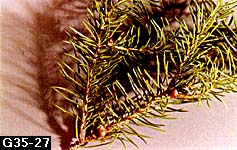
Figure 3—Spruce Bud Scale
Fletcher Scale, Parthenolecanium fletcheri (Figure 4) Back to Table of Contents Appearance: Round, brown scales on twigs, at needle bases. Hosts: Yew, arborvitae, and juniper. Damage: Weakens plants, causing foliage to drop. Copious amounts of honeydew result in noticeable black sooty mold growth. It is more commonly a serious pest of yew than other hosts. Life History: Overwinter as nymphs on branches. They grow quickly in spring, producing noticeable damage and honeydew. Eggs are laid in May and hatch in mid-late June. Newly hatched crawlers look for feeding and overwintering sites. Crawlers do not move far from their hatch site and thus populations can be dense on certain parts of the plant. There is one generation per year.

Figure 4—Fletcher Scale
Oystershell Scale, Lepidosaphes ulmi (Figure 5) Back to Table of Contents Appearance: Purplish-gray, about 3 mm long, and shaped like tiny oystershells. Hosts: Lilac, ash, cotoneaster, willow and many other deciduous trees and shrubs. Damage: Sap-sucking causes cracked bark and chlorotic, stunted foliage. Heavy infestations can kill trees or weaken them to the point of being susceptible to secondary pests such as borers. Life History: Overwinter as eggs beneath the dead mother scale. Crawlers hatch in late May to early June and seek suitable feeding sites on branches and trunks. Nymphs mature in mid-summer to mate. Eggs are laid in late summer to early fall beneath the mother's scale. There is one generation per year.
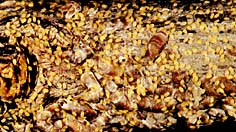
Figure 5—Oystershell Scale Adults and Crawlers (photo courtesy F.B. Peairs)
Scurfy Scale, Chionaspis furfura (Figure 6) Back to Table of Contents Appearance: Females are flat, pear-shaped, dirty whitish-gray and about 3 mm long. Males are similar in appearance but smaller. Hosts: Apple, mountain ash, crabapple, Prunus spp. and many other deciduous plants. Damage: Sap-sucking can cause twig and branch dieback and weaken plants. Life History: Overwinter as eggs beneath the dead mother scale on branches and trunks. Crawlers appear in June and begin feeding on leaves, branches and trunks. Nymphs mature in August, mate and lay overwintering eggs. There is thought to be one generation per year in Minnesota, but a second generation may occur.

Figure 6—Scurfy Scale Adults and Crawlers (photo courtesy W.S. Cranshaw)
Cottony Maple Scale, Pulvinaria innumerabilis (Figure 7) Back to Table of Contents Appearance: The most conspicuous stage is the brown adult female with a large cottony mass (egg sack) protruding from the rear. Females without egg sacs are 2–3 mm long, flat, pale to dark brown and soft. Hosts: Maples (especially silver), honeylocust, linden and other hardwoods. Damage: Infestations are usually not threatening to the health of the plant. Large amounts of honeydew support sooty mold growth. Heavy infestations can cause premature foliage drop and dieback of twigs and branches. Life History: Overwinter as immature, flat females on twigs. They begin growing in spring, and by early summer, the conspicuous, white egg sack appears. Crawlers hatch in late June to early July and move to the undersides of leaves to feed. After spending the summer feeding on the leaves, mated females move back to twigs to overwinter. There is one generation per year.
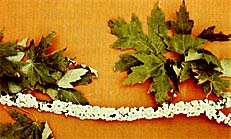
Figure 7—Cottony Maple Scale
European Elm Scale, Gossyparia spuria (Figure 8) Back to Table of Contents Appearance: Mature females are up to 10 mm, oval, reddish-brown with a white, waxy fringe. Blood-like, red liquid results when scales are crushed. Hosts: Elms. Damage: Sap-sucking can cause stunted, chlorotic foliage, premature leaf drop and branch dieback. Associated black sooty mold growth from honeydew secretions on tops of branches gives trees an overall black appearance. Honeydew secretions are also a common nuisance to cars parked under infested elms. Life History: Overwinter as second instar nymphs in bark cracks and crevices. Females mature in late May, mate and begin laying eggs. Crawlers begin appearing in late June and egg hatch may extend through the end of July. Crawlers feed on leaves throughout the summer, then migrate to branches before leaves drop in the fall. There is one generation per year.
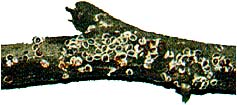
Figure 8—European Elm Scale
Lecanium Scales, Parthenolecanium spp. (Figure 9) Back to Table of Contents Appearance: Females are initially flattened and brown in appearance. As they mature, they become hardened and round. Lecanium scales, as a group, are often difficult to distinguish one from another. The European fruit lecanium scale (Parthenolecanium corni) is probably the most common lecanium scale found in Minnesota on deciduous plants. Hosts: A wide variety of trees and shrubs. Damage: Dieback of twigs and branches as well as host weakening are possible, depending on population levels. Life History: Overwinter as second instar nymphs on twigs. In spring, scales mature and females lay eggs in May and June. Crawlers hatch in June and July and migrate to leaves to feed. In late summer, crawlers migrate back to twigs to overwinter. There is one generation per year.
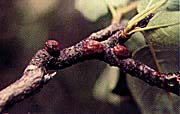
Figure 9—Lecanium Scale (photo courtesy D. A. Leatherman)
There are many other less commonly encountered scales on trees and shrubs in Minnesota that are not illustrated in this publication. For identification and life history information, contact your local Minnesota Extension Service Office.
In order to determine the best time to attempt control, you must determine when the scale is in its most vulnerable stage. For most scale insects, this is directly after egg hatch when the crawlers begin searching for feeding sites, but before they begin producing their protective cover. Use one or more of the following as a guide to determine when scale crawlers are present:
Visual inspections are the most accurate way to determine control times and should be used to confirm the presence of scale infestations. If, however, plants can not be inspected on a regular basis, pest or plant phenologies can be used as guides to determine approximate control times. If available, this information can be obtained from University of Minnesota extension personnel.
Adult scales are generally not affected by insecticides. However, because the crawlers have not secreted their protective cover, they are very vulnerable to insecticides, including alternatives to conventional insecticides such as soaps and oils (Table 1). Some scales have extended egg hatch periods and may require repeat applications to achieve satisfactory control.
In addition to treatment at the crawler stage, some scales are vulnerable in their overwintering phase to horticultural oils used as dormant applications. These oils asphyxiate the scales. Oils should be applied in spring before plant bud break (March-April). There are temperature and host restrictions for applying these oils, so read all labels carefully. Thorough coverage is essential for achieving good control.
| Pesticide Options | Timing/Remarks |
| paraffinic oil (Horticultural Oil) insecticidal soap (Safer's Soap) chlorpyrifos (Dursban) carbaryl (Sevin) acephate (Orthene) malathion (Malathion) | Spray
after crawlers have hatched. A second treatment 10 days later is sometimes necessary. Read label to determine if product is labeled for host in question. |
Caution: Read all insecticide label directions very carefully before buying, and again before using, to ensure proper use.
Robert P. Wawrzynski, Former Research Assistant and
Mark E. Ascerno, Department Head
Department of Entomology
Publication of this brochure was funded in part by the USDA Forest Service, Northeastern Area, State and Private Forestry in cooperation with the Minnesota Department of Natural Resources, Division of Forestry, Urban and Community Forestry Program, and the Minnesota Shade Tree Advisory Committee.

![]()
Produced by Communication and Educational Technology Services, University of Minnesota Extension Service.
In accordance with the Americans with Disabilities Act, this material is available in alternative formats upon request. Please contact your University of Minnesota Extension Service office or the Distribution Center at (800) 876-8636.
The University of Minnesota Extension Service is committed to the policy that all persons shall have equal access to its programs, facilities, and employment without regard to race, color, creed, religion, national origin, sex, age, marital status, disability, public assistance status, veteran status, or sexual orientation.